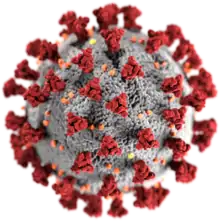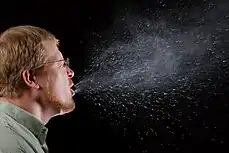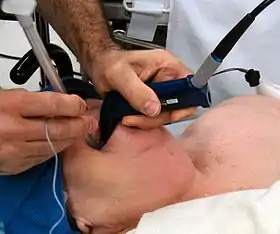Transmission of COVID-19
Coronavirus disease 2019 (COVID-19) spreads from person to person mainly through the respiratory route after an infected person coughs, sneezes, sings, talks or breathes. A new infection occurs when virus-containing particles exhaled by an infected person, either respiratory droplets or aerosols, get into the mouth, nose, or eyes of other people who are in close contact with the infected person.[2][3][4] During human-to-human transmission, an average 1000 infectious SARS-CoV-2 virions are thought to initiate a new infection.[5][6]
| Part of a series on the |
| COVID-19 pandemic |
|---|
 |
|
|
|
The closer people interact, and the longer they interact, the more likely they are to transmit COVID-19. Closer distances can involve larger droplets (which fall to the ground) and aerosols, whereas longer distances only involve aerosols.[4] Larger droplets can also turn into aerosols (known as droplet nuclei) through evaporation.[7] The relative importance of the larger droplets and the aerosols is not clear as of November 2020; however, the virus is not known to spread between rooms over long distances such as through air ducts.[8] Airborne transmission is able to particularly occur indoors, in high risk locations[8] such as restaurants, choirs, gyms, nightclubs, offices, and religious venues, often when they are crowded or less ventilated.[7] It also occurs in healthcare settings, often when aerosol-generating medical procedures are performed on COVID-19 patients.[7]
Although it is considered possible there is no direct evidence of the virus being transmitted by skin to skin contact.[9] A person could get COVID-19 indirectly by touching a contaminated surface or object before touching their own mouth, nose, or eyes,[10] though this is not thought to be the main way the virus spreads, and there is no direct evidence of this method either.[3][9] The virus is not known to spread through feces, urine, breast milk, food, wastewater, drinking water, or via animal disease vectors (although some animals can contract the virus from humans).[10][11] It very rarely transmits from mother to baby during pregnancy.[9]
Social distancing and the wearing of cloth face masks, surgical masks, respirators, or other face coverings are controls for droplet transmission. Transmission may be decreased indoors with well maintained heating and ventilation systems to maintain good air circulation and increase the use of outdoor air.[3]
The number of people generally infected by one infected person varies;[9] as of September 2020 it was estimated that one infected person will, on average, infect between two and three other people.[12] This is more infectious than influenza, but less so than measles.[13] It often spreads in clusters, where infections can be traced back to an index case or geographical location.[14] There is a major role of "super-spreading events", where many people are infected by one person.[9][15][16]
A person who is infected can transmit the virus to others up to two days before they themselves show symptoms, and even if symptoms never appear.[3][12] People remain infectious in moderate cases for 7–12 days, and up to two weeks in severe cases.[12] In October 2020, medical scientists reported evidence of reinfection in one patient.[17][18]
Routes
The relative importance of the larger respiratory droplets and the smaller aerosol particles (airborne transmission) is unknown.[3][8] There has been extensive debate around the traditional distinction between the two forms of transmission,[19] with the UK Government and a review combining them into one "respiratory route".[9] Regardless of whether droplets or aerosols are the dominant route, the risk is always lower outside and with good ventilation.[20]
Respiratory droplets

The virus spreads through respiratory droplets produced when an infected person breathes, coughs, sneezes, or talks. These droplets can land in the mouths or noses of people who are nearby, or possibly be inhaled into the lungs. Spread is more likely when people are in close contact within about 6 feet (1.8 m).[2][12][13]
"Close contact" is variously defined. The U.S. Centers for Disease Control and Prevention (CDC) defines it as "within 6 feet (1.8 m) of an infected person for a cumulative total of 15 minutes or more over a 24-hour period."[21] The European Centre for Disease Prevention and Control states that close proximity is "usually less than 1 meter (3.3 ft) apart."[12] The Australian Health Department defines it as sharing an enclosed space for a prolonged period such as two hours.[22][23]
Social distancing and the wearing of cloth face masks, surgical masks, respirators, or other face coverings are controls for droplet transmission.[13][12] The World Health Organization recommends 1 meter (3.3 ft) of social distance;[2] the U.S. Centers for Disease Control and Prevention recommends 6 feet (1.8 m).[13]
Aerosols
Airborne transmission of COVID-19 has been shown to occur through aerosols containing residual of droplets, that are able to stay suspended in the air for longer periods of time.[2][24] Airborne transmission is able to occur, particularly indoors, such as in restaurants, choir practices, fitness classes, nightclubs, offices, and religious venues, often when they are crowded or less ventilated.[7] It also occurs in healthcare settings, often when aerosol-generating medical procedures performed on COVID-19 patients.[7] Long distance dispersal of virus particles has been detected in ventilation systems of a hospital, indicating the possibility of long range aerosol transmission.[25]
Respiratory
Multiple outbreaks have been reported in indoor locations where infected persons spend long periods of time, such as restaurants and nightclubs.[2][26] This has particularly shown how the virus can spread through the airborne route.[10] There are several well documented examples where COVID-19 has transmitted despite there not being the close proximity required for droplet transmission, including choir practice in Washington, a restaurant in Guangzhou, and a tour bus in Hunan.[27]
The US CDC states that airborne transmission occurs under special circumstances, however they "appear uncommon";[27] whereas ECDC states that the relative importance is unclear,[3] the UK government combines the methods into one “respiratory route” involving large and small droplets, and the Public Health Agency of Canada states that the relative importance is not clear.[8]
Medical
Although long distance dispersal of virus particles has been observed in hospital environment,[25] it is not considered to be as highly airborne as measles or chickenpox.[27]

Some medical procedures performed on COVID-19 patients in health facilities are aerosol-generating.[2][28] WHO recommends the use of filtering facepiece respirators such as N95 masks or FFP2 masks in settings where aerosol-generating procedures are performed,[10] while CDC and the European Centre for Disease Prevention and Control recommend these controls in all situations involving the care of COVID-19 patients (other than during crisis shortages), as respirators are designed to protect the wearer, whereas surgical masks are designed to protect the patient.[29][30][31]
Toilet
There has been concern that toilet aerosols generated by flushing contaminated toilets may spread the COVID-19 virus. WHO recommends that people suspected or confirmed with COVID-19 should use their own toilet, and while flushing the toilet lid should be down to block both droplets and aerosol clouds.[11]
Controversy
Aerosol transmission of the COVID-19 virus outside of medical facilities has been the subject of controversy, with the WHO initially considering it insignificant, which led to widespread criticism from scientists. In July 2020, the WHO changed its guidance, saying that short-range aerosol transmission cannot be ruled out in these situations.[32] In October 2020, it then further changed its guidance, recognizing that although current evidence suggests respiratory droplets is the main method, airborne transmission is occurring, particularly in high risk indoor settings, where there is crowding and less ventilation. It states to avoid the "Three C"s - crowded places, close contact settings, and confined and enclosed spaces.[7]
The U.S. CDC has also been criticized for delays in informing the public about airborne transmission, with John Allan from Harvard University's School of Public Health writing "many scientists have known that airborne transmission of the virus was happening since February. The CDC somehow failed to recognize the accumulating evidence that airborne transmission is important and therefore failed to alert the public."[33][34]
In Canada, the controversy has been attributed to complexities involving the N-95 mask supply chain, and fears that it may run out.[35] The Public Health Agency of Canada recognised airborne transmission in November 2020, stating the relative importance between airborne transmission and large droplet transmission is unknown.[8]
In Australia the controversy involves PPE guidelines, with the Australian Medical Association accusing Professor Lyn Gilbert, chair of the Infection Control Expert Group, of disparaging frontline healthcare workers, accusing them of poor habits and being apathetic.[36][37][38] She argues that provision of N-95 masks gives clinicians a false sense of security, and they are unable to be trained to use them properly, placing them more at risk. She also claims that washing hands after touching contaminated surfaces is more important than use of a respirator, which is recommended for only extraordinary circumstances.[39]
Physical intimacy
The virus spreads through saliva and mucus, and kissing can easily transmit COVID-19. It is possible that direct contact with feces including anilingus may also lead to virus transmission.[40] However, as of July 2020 there have been no published reports of COVID-19 transmission through feces or urine.[10] While COVID‑19 is not a sexually transmitted infection, physical intimacy carries a high risk of transmission due to close proximity.[41]
Hand washing is a control against direct contact transmission.[13] Others include avoiding kissing and avoiding casual sex.[40][41] During physical intimacy, barriers such as face masks, condoms, or dental dams can be used, and socially distanced intimacy can be practiced through mutual masturbation or cybersex.[40]
Mother to child
As of July 2020, there were no cases of transmission from mother to baby during pregnancy.[10][42] Studies have found no viable virus in breast milk.[10] The WHO recommends that mothers with suspected or confirmed COVID-19 should be encouraged to initiate or continue to breastfeed.[10][43]
Objects and surfaces

It may be possible that a person can get COVID-19 by touching a surface or object that has the virus on it (called a fomite), and then touching their own mouth, nose, or possibly their eyes. This is not thought to be the main way the virus spreads.[2][3][9][10][12][13] Viable virus or RNA has been detected on contaminated surfaces for periods ranging from hours to days, depending on environmental conditions. As of July 2020, there were no specific reports which directly demonstrated transmission via fomites, although fomite transmission is hard to distinguish from transmission from the infectious person themselves, and fomite transmission was still considered a likely mode of transmission.[10]
On surfaces the amount of viable active virus decreases over time until it can no longer cause infection. One study indicated that the virus can be detected for up to four hours on copper, up to one day on cardboard, and up to three days on plastic (polypropylene) and stainless steel (AISI 304).[12][44][45] In October 2020, medical researchers concluded the COVID-19 virus can remain on common surfaces for up to 28 days.[46]
Hand washing and periodic cleaning of surfaces are controls against indirect contact transmission through fomites.[2] Surfaces are easily decontaminated with household disinfectants which destroy the virus outside the human body. Disinfectants or bleach are not a treatment for COVID‑19, and cause health problems when not used properly, such as when used on or inside the human body.[2][47][48]
Food and water
There is currently no evidence to support transmission of COVID-19 associated with food.[49][50]
While virus RNA has been found in untreated wastewater, as of May 2020 there is little evidence of infectious virus in wastewater or drinking water.[11][51][52]
After COVID-19 outbreak in Beijing in June, food transmission evidence has been disclosed in China early July 2020 by the detection of SARS-CoV-2 on frozen foods, including their packaging materials and storage environments.[54] On Oct 17, China CDC reports that they separated out live SARS-CoV-2 virus from packaging of cold chain imported food, during investigation of another outbreak in Qingdao in October.[55] As of October, there is no direct evidence of general public contracting the virus from contaminated food packaging.
Animal vectors
There are a small number of cases of spread from people to pets, including cats and dogs. Other cases include lions and tigers at a New York zoo, and minks on farms in the Netherlands.[56][57] In a laboratory settings, animals shown to be infected include ferrets, cats, golden Syrian hamsters, rhesus macaques, cynomolgus macaques, grivets, common marmosets, and dogs.[56][58][59] By contrast, mice, pigs, chickens, and ducks do not seem to become infected or spread the infection.[56] There is no evidence that insect disease vectors such as mosquitoes or ticks spread COVID-19.[49]
CDC recommends that pet owners limit their pet's interaction with people outside their household. Face coverings are not recommended on pets because covering a pet's face could harm them, and they should not be disinfected with cleaning products not approved for animal use.[60] People sick with COVID-19 should avoid contact with pets and other animals.[58][60]
The risk of COVID-19 spreading from animals to people is considered to be low. Although the virus likely originated in bats, the pandemic is sustained through human-to-human spread.[56][58] Pets do not appear to play a role in spreading COVID-19, but there are reports from infected mink farms indicating transmission to humans is a possibility.[58]
Reproduction number
It transmits very easily and sustainably, however the number of people generally infected by one infected person varies.[9] Many people do not transmit the virus, but some transmit to many people; therefore the virus is considered to be "overdispersed".[9][61] As of September 2020 it was estimated that, on average, one infected person will infect between two and three other people.[12] This is more infectious than influenza, but less so than measles.[13]
Estimates of the number of people infected by one person with COVID-19, the R0, have varied. The WHO's initial estimates of R0 were 1.4–2.5 (average 1.95); however an early April 2020 review found the median R0 to be 5.7.[62]
It often spreads in clusters, where infections can be traced back to an index case or geographical location.[14] There is a major role of "super-spreading events", where many people are infected by one person.[9] These generally occur usually indoors, where groups of people remain in poor ventilation for longer periods.[9] It transmits via aerosols particularly in these crowded and confined indoor spaces, which are particularly effective for transmitting the virus, such as restaurants, nightclubs or choirs.[3][7][63] Another important site for transmission is between members of the same household.[9]
Source control may be used to partially inhibit spread.
Duration of transmissibility
People are most infectious when they show symptoms, even if mild or non-specific, but may be infectious for up to two days before symptoms appear. They remain infectious an estimated seven to twelve days in moderate cases and an average of two weeks in severe cases.[2][12] Research has indicated that viral load peaks around the day of symptom onset and declines after, as measured by RNA studies.[10]
The possibility of transmission for completely asymptomatic cases is unclear.[2][12] A systematic review estimated that the proportion of truly asymptomatic cases ranges from 6% to 41%, with some limitations ("asymptomatic" was not very well defined). Another study with a clear definition of asymptomatic infections estimated a proportion of 23%.[10]
Reinfection
In October 2020, medical scientists reported evidence, for the first time in the U.S. and fifth worldwide, of reinfection.[17][18]
See also
References
- "Q&A: How is COVID-19 transmitted? (How is the virus that causes COVID-19 most commonly transmitted between people?)". www.who.int. 9 July 2020. Retrieved 14 October 2020.
- "Transmission of COVID-19". www.ecdc.europa.eu. 7 September 2020. Retrieved 14 October 2020.
- "Frequently Asked Questions (Spread)". www.cdc.gov. 9 October 2020. Retrieved 14 October 2020.
- Popa, Alexandra; et al. (23 November 2020). "Genomic epidemiology of superspreading events in Austria reveals mutational dynamics and transmission properties of SARS-CoV-2". Science Translational Medicine: eabe2555. doi:10.1126/scitranslmed.abe2555. PMID 33229462. S2CID 227157558. Retrieved 1 December 2020.
- Prentiss, Mara; et al. (23 October 2020). "Superspreading Events Without Superspreaders: Using High Attack Rate Events to Estimate Nº for Airborne Transmission of COVID-19". medRxiv. doi:10.1101/2020.10.21.20216895. S2CID 225040713. Retrieved 1 December 2020.
- "Q&A: How is COVID-19 transmitted? (What do we know about aerosol transmission?)". www.who.int. 9 July 2020. Retrieved 14 October 2020.
- "COVID-19: Main modes of transmission". Public Health Agency of Canada. 3 November 2020. Retrieved 25 November 2020.
- Meyerowitz EA, Richterman A, Gandhi RT, Sax PE (September 2020). "Transmission of SARS-CoV-2: A Review of Viral, Host, and Environmental Factors". Annals of Internal Medicine. doi:10.7326/M20-5008. PMC 7505025. PMID 32941052.
- "Transmission of SARS-CoV-2: implications for infection prevention precautions" (PDF). www.who.int. World Health Organization. 9 July 2020. Archived from the original on 9 July 2020. Retrieved 18 September 2020.
- "Water, sanitation, hygiene, and waste management for SARS-CoV-2, the virus that causes COVID-19" (PDF). www.who.int. 29 July 2020. Retrieved 14 October 2020.
- "Q & A on COVID-19: Basic facts". www.ecdc.europa.eu. 25 September 2020. Retrieved 8 October 2020.
- "How COVID-19 Spreads". www.cdc.gov. 5 October 2020. Retrieved 7 October 2020.
- Liu T, Gong D, Xiao J, Hu J, He G, Rong Z, Ma W (October 2020). "Cluster infections play important roles in the rapid evolution of COVID-19 transmission: A systematic review". International Journal of Infectious Diseases. 99: 374–380. doi:10.1016/j.ijid.2020.07.073. PMC 7405860. PMID 32768702.
- Enserink M, Kupferschmidt K, Desai N. "Gyms. Bars. The White House. See how superspreading events are driving the pandemic". vis.sciencemag.org. Retrieved 18 November 2020.
- Wong F, Collins JJ (November 2020). "Evidence that coronavirus superspreading is fat-tailed". Proceedings of the National Academy of Sciences of the United States of America. 117 (47): 29416–29418. doi:10.1073/pnas.2018490117. PMID 33139561. S2CID 226242440.
- Herscher R (12 October 2020). "Scientists Confirm Nevada Man Was Infected Twice With Coronavirus". NPR. Retrieved 12 October 2020.
- Tillett RL, Sevinsky JR, Hartley PD, Kerwin H, Crawford N, Gorzalski A, et al. (October 2020). "Genomic evidence for reinfection with SARS-CoV-2: a case study". The Lancet. Infectious Diseases. doi:10.1016/S1473-3099(20)30764-7. PMC 7550103. PMID 33058797. S2CID 222295687.
- National Academies Of Sciences E, Staudt A, Saunders J, Pavlin J, Shelton-Davenport M, et al. (Environmental Health Matters Initiative, National Academies of Sciences, Engineering, and Medicine) (22 October 2020). Shelton-Davenport M, Pavlin J, Saunders J, Staudt A (eds.). Airborne Transmission of SARS-CoV-2: Proceedings of a Workshop in Brief. Washington, D.C.: National Academies Press. doi:10.17226/25958. ISBN 978-0-309-68408-8. PMID 33119244.
- The Lancet Respiratory Medicine (October 2020). "COVID-19 transmission-up in the air". The Lancet. Respiratory Medicine. 8 (12): 1159. doi:10.1016/s2213-2600(20)30514-2. PMC 7598535. PMID 33129420.
- CDC. "Coronavirus Disease 2019 (COVID-19)". Centers for Disease Control and Prevention. Retrieved 22 October 2020.
- "Quarantine for coronavirus (COVID-19)". Australian Government Department of Health. Retrieved 25 September 2020.
- "How COVID-19 Spreads". U.S. Centers for Disease Control and Prevention (CDC). 18 September 2020. Archived from the original on 19 September 2020. Retrieved 20 September 2020.
- de Oliveira, P. M.; Mesquita, L. C. C.; Gkantonas, S.; Giusti, A.; Mastorakos, E. (27 January 2021). "Evolution of spray and aerosol from respiratory releases: theoretical estimates for insight on viral transmission". Proceedings of the Royal Society A: Mathematical, Physical and Engineering Sciences. 477 (2245): 20200584. doi:10.1098/rspa.2020.0584.
- Nissen K, Krambrich J, Akaberi D, Hoffman T, Ling J, Lundkvist Å, et al. (November 2020). "Long-distance airborne dispersal of SARS-CoV-2 in COVID-19 wards". Scientific Reports. 10 (1): 19589. doi:10.1038/s41598-020-76442-2. PMC 7659316. PMID 33177563.
- Leclerc QJ, Fuller NM, Knight LE, Funk S, Knight GM (5 June 2020). "What settings have been linked to SARS-CoV-2 transmission clusters?". Wellcome Open Research. 5: 83. doi:10.12688/wellcomeopenres.15889.2. PMC 7327724. PMID 32656368.
- "Scientific Brief: SARS-CoV-2 and Potential Airborne Transmission". CDC. 5 October 2020. Retrieved 23 November 2020.
- Tran K, Cimon K, Severn M, Pessoa-Silva CL, Conly J (2012). "Aerosol generating procedures and risk of transmission of acute respiratory infections to healthcare workers: a systematic review". PLOS ONE. 7 (4): e35797. Bibcode:2012PLoSO...735797T. doi:10.1371/journal.pone.0035797. PMC 3338532. PMID 22563403.
- "Infection prevention and control and preparedness for COVID-19 in healthcare settings - fifth update" (PDF).
- "Respiratory Protection During Outbreaks: Respirators versus Surgical Masks | | Blogs | CDC". Retrieved 25 November 2020.
- CDC (11 February 2020). "Coronavirus Disease 2019 (COVID-19)". Centers for Disease Control and Prevention. Retrieved 29 November 2020.
- Lewis D (July 2020). "Mounting evidence suggests coronavirus is airborne - but health advice has not caught up". Nature. 583 (7817): 510–513. Bibcode:2020Natur.583..510L. doi:10.1038/d41586-020-02058-1. PMID 32647382. S2CID 220470431.
- Zhang R, Li Y, Zhang AL, Wang Y, Molina MJ (June 2020). "Identifying airborne transmission as the dominant route for the spread of COVID-19". Proceedings of the National Academy of Sciences of the United States of America. 117 (26): 14857–14863. doi:10.1073/pnas.2009637117. PMC 7334447. PMID 32527856.
- Tanne JH (September 2020). "Covid-19: CDC publishes then withdraws information on aerosol transmission". BMJ. 370: m3739. doi:10.1136/bmj.m3739. PMID 32973037. S2CID 221881893.
- "Canada's top doctor has been hesitant to say tiny airborne particles are spreading COVID-19. Under pressure, she reconsiders | FR24 News English". Retrieved 25 October 2020.
- "Poor habits, apathetic medicos to blame". www.theaustralian.com.au. Retrieved 20 November 2020.
- "Letter to Professor Gilbert" (PDF).
- Readfearn G (20 November 2020). "Australian Medical Association accuses Covid infection control group chair of 'tone deaf' comments". The Guardian. ISSN 0261-3077. Retrieved 20 November 2020.
- "GPs 'perfectly safe' assessing potential coronavirus cases: ICAG".
- "Sex and Coronavirus Disease 2019 (COVID-19)" (PDF). New York City Department of Health. 6 August 2020. Retrieved 13 August 2020.
- "COVID-19 and Our Communities". ACON (New South Wales). 3 August 2020. At section "Sex and COVID-19". Retrieved 13 August 2020.
- "Q & A on COVID-19: Medical information". European Centre for Disease Prevention and Control. 24 April 2020. Retrieved 21 August 2020.
- "Breastfeeding and COVID-19" (PDF). www.who.int. World Health Organization. 23 June 2020. Archived from the original on 23 June 2020. Retrieved 18 September 2020.
- "New coronavirus stable for hours on surfaces". National Institutes of Health. 17 March 2020. Archived from the original on 23 March 2020. Retrieved 30 April 2020.
- van Doremalen N, Bushmaker T, Morris DH, Holbrook MG, Gamble A, Williamson BN, et al. (April 2020). "Aerosol and Surface Stability of SARS-CoV-2 as Compared with SARS-CoV-1". The New England Journal of Medicine. 382 (16): 1564–1567. doi:10.1056/NEJMc2004973. PMC 7121658. PMID 32182409.
- Riddell S, Goldie S, Hill A, Eagles D, Drew TW (October 2020). "The effect of temperature on persistence of SARS-CoV-2 on common surfaces". Virology Journal. 17 (1): 145. doi:10.1186/s12985-020-01418-7. PMC 7538848. PMID 33028356. S2CID 222178243.
- "Household cleaners and disinfectants can cause health problems when not used properly". U.S. Centers for Disease Control and Prevention (CDC). 24 April 2020. Retrieved 6 May 2020.
- "COVID-19: Cleaning And Disinfecting Your Home". www.cdc.gov. 27 May 2020. Retrieved 7 October 2020.
- "Coronavirus Disease 2019 (COVID-19): Frequently Asked Questions". www.cdc.gov. 15 July 2020. Retrieved 24 July 2020.
- "Q&A on COVID-19: Various". European Centre for Disease Prevention and Control. 24 April 2020. Retrieved 21 August 2020.
- Corpuz MV, Buonerba A, Vigliotta G, Zarra T, Ballesteros F, Campiglia P, et al. (November 2020). "Viruses in wastewater: occurrence, abundance and detection methods". The Science of the Total Environment. 745: 140910. Bibcode:2020ScTEn.745n0910C. doi:10.1016/j.scitotenv.2020.140910. PMC 7368910. PMID 32758747.
- "Information for Sanitation and Wastewater Workers on COVID-19". U.S. Centers for Disease Control and Prevention. 28 May 2020. Retrieved 13 August 2020.
- "China has zeroed in on frozen food imports as it tries to keep a lid on Covid-19". 14 November 2020.
- "中国疾病预防控制中心在冷链食品外包装分离到新冠活病毒" (in Chinese). 17 October 2020.
- "COVID-19 and Animals". www.cdc.gov. 22 June 2020. Retrieved 7 October 2020.
- "USDA Statement on the Confirmation of COVID-19 in a Tiger in New York". United States Department of Agriculture. 5 April 2020. Archived from the original on 15 April 2020. Retrieved 16 April 2020.
- "Questions and Answers on COVID-19". World Organisation for Animal Health. 9 June 2020. Retrieved 23 July 2020.
- Bosco-Lauth AM, Hartwig AE, Porter SM, Gordy PW, Nehring M, Byas AD, et al. (October 2020). "Experimental infection of domestic dogs and cats with SARS-CoV-2: Pathogenesis, transmission, and response to reexposure in cats". Proceedings of the National Academy of Sciences of the United States of America. 117 (42): 26382–26388. doi:10.1073/pnas.2013102117. PMC 7585007. PMID 32994343. S2CID 222170541.
- "COVID-19: If You Have Pets". www.cdc.gov. 28 June 2020. Retrieved 24 July 2020.
- Endo A, Abbott S, Kucharski AJ, Funk S (2020). "Estimating the overdispersion in COVID-19 transmission using outbreak sizes outside China". Wellcome Open Research. 5: 67. doi:10.12688/wellcomeopenres.15842.3. PMC 7338915. PMID 32685698.
- Sanche S, Lin YT, Xu C, Romero-Severson E, Hengartner N, Ke R (July 2020). "High Contagiousness and Rapid Spread of Severe Acute Respiratory Syndrome Coronavirus 2". Emerging Infectious Diseases. 26 (7): 1470–1477. doi:10.3201/eid2607.200282. PMC 7323562. PMID 32255761. S2CID 215410037.
- Kohanski MA, Lo LJ, Waring MS (July 2020). "Review of indoor aerosol generation, transport, and control in the context of COVID-19". International Forum of Allergy & Rhinology. n/a (n/a): 1173–1179. doi:10.1002/alr.22661. PMC 7405119. PMID 32652898.
External links
- A room, a bar and a classroom (visualization of how COVID-19 does and doesn't spread)
